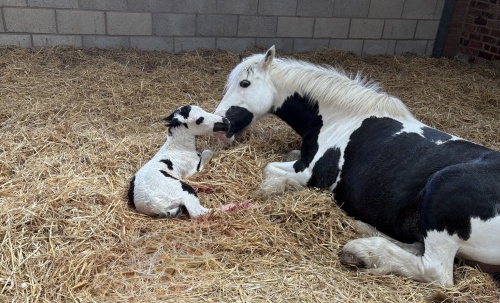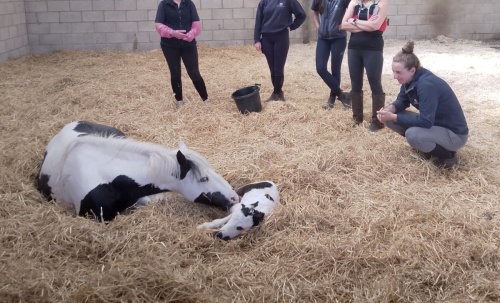Maintaining the health of pregnant mares is one of the highest priorities on any breeding farm. From conception to foaling, every stage of gestation demands careful management—not just in nutrition and environment but also in physical activity. Exercise during pregnancy plays a critical role in supporting the overall health of the mare, encouraging optimal fetal development, reducing the risk of musculoskeletal issues, and preparing the mare for an easier foaling process.

However, not all exercise is created equal, especially during pregnancy. The challenge lies in determining the appropriate type, intensity, and duration of exercise throughout the gestational timeline. Trong bài viết này, I’ll share an overview of recommended exercise routines for pregnant horses based on current veterinary knowledge, equine physiology, and global breeding practices. The goal is to help farm owners and breeders strike the right balance between rest and movement—ensuring a healthy outcome for both the mare and foal.
Understanding the Pregnant Mare’s Physiology
A pregnant mare undergoes a wide range of hormonal, metabolic, and biomechanical changes. Typically, equine gestation lasts around 340 Ngày (approximately 11 months), and the changes are most noticeable in the last trimester, when fetal growth accelerates.
During early pregnancy (up to 4 months), physical changes are minimal, and most mares can continue their regular routines. From 5 đến 8 months, the uterus begins to expand significantly, and weight distribution shifts. In the final trimester (last 3 months), the mare gains substantial weight, and her balance, respiratory efficiency, and stamina may decline.
Foreign veterinary guidelines often recommend adapting exercise schedules around these physiological milestones. According to the American Association of Equine Practitioners (AAEP), mild to moderate exercise is beneficial for most pregnant mares, but intense work or competition should be avoided after the fifth month.
Benefits of Exercise for Pregnant Horses
Maintaining a structured but gentle exercise routine during pregnancy has several well-documented advantages, both from a veterinary and practical perspective:
-
Improved Circulation: Regular movement enhances blood flow, which supports the health of both the uterus and developing fetus.
-
Muscle Tone Maintenance: Exercise helps mares retain core and limb muscle strength, improving their ability to carry additional weight as pregnancy advances.
-
Digestive Health: Physical activity aids in digestion and reduces the likelihood of colic, a common concern in sedentary pregnant mares.
-
Foaling Preparedness: Exercise reduces stiffness and enhances joint flexibility, making the labor process smoother and lowering the risk of dystocia (difficult birth).
-
Behavioral Calmness: Light movement keeps mares mentally stimulated, reducing stress, boredom, and associated behavioral issues.
European and Australian breeders, particularly those in pasture-based systems, report fewer foaling complications and better mare recovery when mares are kept physically active through controlled turnout and gentle handling.
Exercise Recommendations by Trimester
First Trimester (0–4 Months)
-
Activity Level: Normal work can generally continue unless otherwise advised by a veterinarian.
-
Type of Exercise: Light to moderate riding, turnout in paddocks, walking under saddle, or lunging.
-
Precautions: Avoid strenuous jumping, racing, or prolonged high-speed exercise. Make sure the mare is not overworked during hot or humid conditions.
Many breeding farms in the U.S. continue to work mares during this period, especially if the pregnancy is newly confirmed and the embryo has implanted securely. According to research by the University of Kentucky Equine Research Center, no adverse effects have been linked to light exercise in early pregnancy.
Second Trimester (5–8 Months)
-
Activity Level: Reduce intensity as the pregnancy progresses.
-
Type of Exercise: Walking or trotting under saddle for 20–30 minutes, turnout in safe pastures, hand-walking or light lunging.
-
Precautions: Avoid fast galloping, rough terrain, and any risk of slipping or falling. Monitor for signs of fatigue, back soreness, or swelling in the limbs.
This is often the phase where breeders shift from riding to ground-based movement. In countries like Germany and the Netherlands, mares are often housed in group paddocks with ample space for self-regulated exercise.
Third Trimester (9–11 Months)
-
Activity Level: Focus on gentle, short-duration movement. No strenuous work.
-
Type of Exercise: Daily turnout, hand-walking, or slow lead-line walking.
-
Precautions: Close monitoring is critical. Look for signs of discomfort, swelling, or abnormal behavior. Minimize any risk of falling or exposure to aggressive herd mates.
In this phase, exercise becomes more about comfort and preventing stiffness than building fitness. Breeding farms often adjust routines to include indoor walking during poor weather and provide deep bedding to cushion joints during rest.

Managing Group Turnout for Pregnant Mares
Foreign breeding farms emphasize the importance of social management in exercise routines. Turnout in compatible groups allows for natural movement, which is often the best form of low-impact exercise. However, careful attention must be paid to social dynamics to avoid aggressive interactions.
Veterinarians in the UK advise separating aggressive or overly playful mares from pregnant ones to prevent injuries. Good pasture management—ample space, soft footing, and access to shelter—enhances the safety and effectiveness of turnout as a daily exercise method.
Environmental and Seasonal Considerations
Pregnant mares are particularly sensitive to temperature extremes, footing conditions, and pasture quality. For instance:
-
Winter: In Nordic and Canadian breeding farms, indoor arenas are used for daily hand-walking when snow or ice makes outdoor turnout dangerous.
-
Summer: Heat stress must be avoided. Farms in southern U.S. states and Australia often schedule walks in early morning or late evening and provide cooling showers after movement.
Stable ventilation, shade, hydration, and protective gear (such as fly sheets or leg wraps) also contribute to exercise safety and comfort.
When to Restrict or Cease Exercise
While movement is generally beneficial, there are specific conditions where exercise should be limited or stopped altogether:
-
Signs of lameness, swelling, or pain
-
Risk of abortion or history of pregnancy complications
-
Placentitis or abnormal discharge
-
Veterinary diagnosis of high-risk pregnancy
In such cases, confined rest and veterinary treatment take precedence. Monitoring via ultrasonography—especially color Doppler and B-mode scans—can help detect uterine health issues or signs of fetal stress that would otherwise go unnoticed.
Practical Farm Tips for Implementing Exercise Programs
-
Consistency: Keep exercise schedules regular. Irregular routines may cause more stress than inactivity.
-
Surface Matters: Always exercise on soft, even surfaces to reduce concussion and slipping risks.
-
Observation: After each session, observe for signs of fatigue, soreness, or behavioral changes.
-
Record Keeping: Maintain detailed logs of each mare’s exercise, condition, and temperament. This supports long-term reproductive planning and veterinary assessments.
-
Veterinary Collaboration: Regular checkups (including ultrasound evaluations) help ensure the mare’s condition aligns with her exercise routine.
International Perspectives and Research Support
In Japan, studies by the Equine Research Institute have shown that light daily exercise improved placental thickness and foal viability in older mares. Similarly, a Canadian study published in the Journal of Equine Veterinary Science (2022) found that controlled exercise reduced postpartum complications and improved uterine involution rates.
Internationally, breeders agree that moderation, not elimination, is key. Avoiding complete stall rest unless medically necessary is now considered standard best practice.
Kết thúc
Exercise is not only safe for pregnant mares—it’s highly recommended when managed with care and veterinary guidance. From promoting fetal development to reducing the risk of delivery complications, physical activity plays a central role in successful breeding outcomes.
For farm managers and horse breeders, the focus should be on developing trimester-specific, low-risk exercise programs. This includes regular turnout, hand-walking, and light riding in the early months, followed by gentler activities as gestation progresses.
Ultimately, consistent movement—combined with good nutrition, clean environments, and regular veterinary monitoring—supports healthier mares, stronger foals, and fewer complications at foaling. As global breeding standards evolve, more farms are recognizing exercise not as an optional luxury, but as an essential component of equine pregnancy care.
References:
-
American Association of Equine Practitioners (AAEP). (2024). “Care of the Pregnant Mare.” https://aaep.org/horsehealth/care-pregnant-mare
-
Journal of Equine Veterinary Science. (2022). “Impact of Controlled Exercise on Uterine Health in Pregnant Mares.” https://www.j-evs.com/
-
University of Kentucky Equine Research Center. (2023). “Physiology and Management of the Pregnant Mare.” https://afs.ca.uky.edu/equine
-
Equine Research Institute, Japan Racing Association. (2021). “Exercise and Placental Development in Aging Mares.” https://jra.jp/